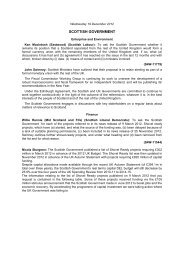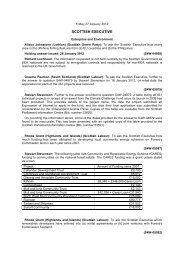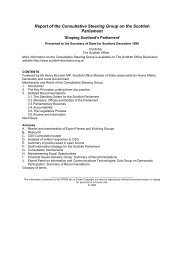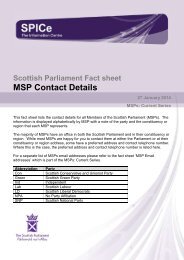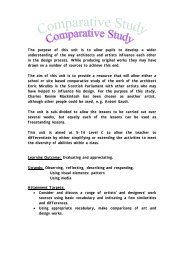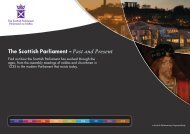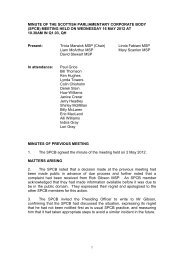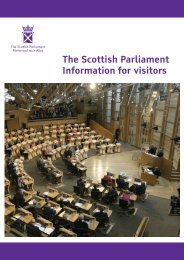Highlands and Islands Airport's Annual Report (3MB pdf - Scottish ...
Highlands and Islands Airport's Annual Report (3MB pdf - Scottish ...
Highlands and Islands Airport's Annual Report (3MB pdf - Scottish ...
Create successful ePaper yourself
Turn your PDF publications into a flip-book with our unique Google optimized e-Paper software.
20<br />
HIGHLANDS AND ISLANDS AIRPORTS LIMITED<br />
DIRECTORS’ REPORT<br />
THE DIRECTORS SUBMIT THEIR REPORT AND THE GROUP FINANCIAL<br />
STATEMENTS FOR THE YEAR ENDED 31 MARCH 2011<br />
PRINCIPAL ACTIVITY<br />
The Group’s principal activity during the<br />
year continued to be the provision <strong>and</strong><br />
operation of safe, secure <strong>and</strong> efficient<br />
airports which support the communities<br />
we serve.<br />
RESULTS AND DIVIDENDS<br />
The Group’s operating loss for the year<br />
amounted to £2,555,000 (2010: profit<br />
£266,000), which when compared with<br />
the prior year reflects another challenging<br />
year with the impacts of a reduction in the<br />
Group’s operating subsidy of £1,100,000,<br />
volcanic ash disruption <strong>and</strong> another harsh<br />
winter contributing to negative variances<br />
in revenues <strong>and</strong> operating costs.<br />
The parent company loss after taxation<br />
amounted to £2,339,000 (2010: profit<br />
£599,000). The directors recommend<br />
that no dividend be paid, leaving the full<br />
amount to be retained within reserves.<br />
REVIEW OF THE BUSINESS<br />
Subsidies from <strong>Scottish</strong> Government<br />
received for the year ended 31 March<br />
2011 totalled £25,256,000 (2010:<br />
£26,471,000) made up of revenue<br />
of £18,256,000 (2010: £19,471,000)<br />
<strong>and</strong> capital of £7,000,000 (2010:<br />
£7,000,000).<br />
Passenger numbers <strong>and</strong> aircraft movements<br />
across the Group decreased by 5% <strong>and</strong><br />
7% respectively in the year. Excluding<br />
Dundee Airport these variance have<br />
decreased by 5% <strong>and</strong> 6% respectively.<br />
Freight tonnage decreased by 24%.<br />
FUTURE DEVELOPMENTS<br />
The directors aim to ensure that the<br />
Group continues to operate <strong>and</strong> manage<br />
its 11 airports in accordance with <strong>Scottish</strong><br />
Ministerial policy <strong>and</strong> to support the social<br />
<strong>and</strong> economic welfare of the areas<br />
concerned. Significant changes in the<br />
present nature of the business are not<br />
expected in the near future.<br />
CAPITAL EXPENDITURE<br />
Investment in property, plant <strong>and</strong><br />
equipment amounted to £4,838,000.<br />
Major works undertaken included:–<br />
a) At Islay, a project commenced to<br />
replace the aerodrome’s ground lighting<br />
at a cost of £729,000. An aircraft<br />
navigational aid was replaced at a<br />
cost of £115,000.<br />
b) At Sumburgh, an overlay of the second<br />
runway was carried out at a cost of<br />
£1,488,000 <strong>and</strong> the northern taxiway<br />
was resurfaced at a cost of £294,000.<br />
Hold baggage x-ray screening<br />
equipment was installed at a cost<br />
of £197,000.<br />
c) At Wick, a project commenced to<br />
replace the aerodrome’s ground<br />
lighting at a cost of £198,000.<br />
d) Across the Group, an additional<br />
£399,000 was spent on enhanced<br />
security measures, including £310,000<br />
on explosive trace detection equipment.<br />
AIRPORT CONSULTATIVE<br />
COMMITTEES<br />
Airport consultative committees are<br />
established at each airport. These provide<br />
a forum for the discussion of all matters<br />
concerning the development or operation<br />
of the airport, which have an impact on the<br />
users of the airport <strong>and</strong> on people living<br />
<strong>and</strong> working in the surrounding area.<br />
Consultative committees are a means of<br />
keeping all interested parties informed<br />
of matters affecting them, of providing<br />
an opportunity to reconcile differences<br />
of view, resolve difficulties <strong>and</strong> assess<br />
recommendations made by the constituent<br />
members. Additionally representation<br />
is made at various transport forums<br />
when requested.<br />
SAFETY AND SECURITY<br />
The Group is committed to operating<br />
safe <strong>and</strong> secure airports.<br />
AIR NAVIGATION SERVICE<br />
PROVIDER (ANSP)<br />
In accordance with EC Single European<br />
Sky legislation, HIAL is certificated <strong>and</strong><br />
designated as an ANSP by the UK Civil<br />
Aviation Authority (“the regulator”).<br />
The following information for the year<br />
2010/11 is provided in accordance<br />
with the reporting requirements set<br />
out in Commission Regulation (EC)<br />
No 2096/2005.<br />
• Inverness:<br />
The Thales Primary Surveillance Radar<br />
<strong>and</strong> Mode S Secondary Surveillance<br />
Radar, introduced in July 2008, has had a<br />
very positive impact on the environment<br />
in terms of fuel burn, track miles flown<br />
<strong>and</strong> noise footprint since its introduction.<br />
In terms of mitigation in relation to<br />
sustainable energy projects, one major<br />
wind farm developer has made a<br />
significant financial input towards the<br />
cost of a technological mitigation<br />
against the effects of wind turbines<br />
on the Inverness radar. This project is<br />
ongoing <strong>and</strong> it is anticipated that the<br />
technical solution will be available<br />
during the next financial year.<br />
• Benbecula, Dundee, Kirkwall,<br />
Stornoway, Sumburgh <strong>and</strong> Wick:<br />
HIAL will continue to provide an air<br />
traffic control service to meet customer<br />
requirements. This includes providing<br />
on call facilities for lifeline services<br />
including air ambulance <strong>and</strong> search <strong>and</strong><br />
rescue. We will investigate <strong>and</strong> evaluate<br />
approach control services with new<br />
surveillance technologies as they<br />
become available. A study to determine<br />
the best provision of a continued radar<br />
service for Sumburgh Airport (currently<br />
provided by NATS under contract from<br />
Aberdeen Airport) was conducted<br />
during the reporting period which<br />
resulted in NATS being re awarded<br />
the radar approach contract, but at a<br />
significantly reduced cost to HIAL.<br />
• Barra, Campbeltown, Islay <strong>and</strong> Tiree:<br />
HIAL will continue to provide a basic<br />
air traffic service (a flight information<br />
service) to meet the requirements of<br />
our customers<br />
HIAL has advised the regulator of its<br />
intention to engage in the development<br />
of GNSS (an instrument approach<br />
utilising satellite technology)<br />
approaches at group airports. This is<br />
particularly important at those airports<br />
whose main approach aid is a Very<br />
High Frequency Omni-directional Radio<br />
Range (VOR) since these navigation<br />
aids will be withdrawn from service<br />
over the next 5 to 15 years.<br />
The revised safety management system<br />
was implemented on 1 June 2010 <strong>and</strong><br />
has been “approved” by the regulator.<br />
The system continues to evolve under<br />
the auspices of continuous improvement.<br />
A quality management system is still<br />
being considered.<br />
Safety is assured <strong>and</strong> maintained by<br />
utilising the SMS to manage any proposed<br />
operational <strong>and</strong> organisational changes<br />
<strong>and</strong> to audit existing procedures. The<br />
revised system encompasses all aspects<br />
of the business <strong>and</strong> has embedded<br />
incident investigation requirements.<br />
A complete review of winter operations<br />
took place following the severe weather<br />
experienced between December 2010<br />
<strong>and</strong> February 2011. This resulted in<br />
improvements in equipment provision,<br />
staff training <strong>and</strong> operational procedures.<br />
Key performance indicators are evolving<br />
<strong>and</strong> are available on request. An internal<br />
Compliance <strong>and</strong> Assurance programme<br />
consisting of phased auditing, in addition<br />
to any regulatory requirements, is in place.<br />
The Group continues to develop risk<br />
management procedures <strong>and</strong> processes.<br />
This is overseen by the Risk Oversight<br />
Group with a report presented to each<br />
Board Meeting.<br />
SUPPLIER PAYMENT POLICY<br />
AND PRACTICE<br />
It is Company policy that payments to<br />
suppliers are made in accordance with<br />
terms <strong>and</strong> conditions agreed between<br />
the company <strong>and</strong> its suppliers, provided<br />
that all trading terms <strong>and</strong> conditions have<br />
been complied with. At 31 March 2011<br />
the Company had an average of 13 days’<br />
purchases owed to trade creditors (2010:<br />
17 days, 2009: 26 days).<br />
HUMAN RESOURCES<br />
At the year-end the Group employed<br />
584 people, of which 19 were employed<br />
on a relief basis. This represents a small<br />
decrease on the previous year’s total (598<br />
inclusive of relief staff). Active management<br />
of staff levels <strong>and</strong> vacancies is a continuous<br />
process <strong>and</strong> this year has seen a moderate<br />
level of staff turnover through retirement,<br />
resignation, <strong>and</strong> termination with 68<br />
individuals leaving the Group. These<br />
changes resulted in opportunities for<br />
40 internal staff changes. Over the course<br />
of the year the Group undertook 65<br />
recruitment exercises, which is slightly fewer<br />
than last year <strong>and</strong> appears to be indicative<br />
of the current employment market.<br />
Over the year, as part of this active<br />
management of staff levels, some posts<br />
have been left vacant after post holders<br />
left through natural turnover <strong>and</strong> this also<br />
created opportunities for a review of<br />
workloads leading to opportunities to<br />
amalgamate responsibilities with other<br />
posts. This has been balanced out with<br />
the creation of some new posts, such as<br />
a Trainee Airport Manager role which is<br />
providing an existing member of staff the<br />
opportunity to develop their skills <strong>and</strong><br />
allows the Group to succession plan.<br />
Overall staffing numbers have remained<br />
relatively stable.<br />
ORGANISATIONAL<br />
DEVELOPMENT<br />
There is a continued <strong>and</strong> increasing focus<br />
on organisational development, aimed at<br />
achieving excellence through improved<br />
performance <strong>and</strong> decision-making.<br />
Communication to staff flows through the<br />
management structure of the company<br />
on a regular basis <strong>and</strong> given the remote<br />
nature of our aerodromes remains<br />
challenging. We remain Investors in<br />
People accredited, <strong>and</strong> work towards<br />
reaccreditation is on-going <strong>and</strong> remains<br />
a continuous priority.<br />
EMPLOYMENT POLICIES<br />
The HR team has continued to focus<br />
this year on further development of a<br />
framework of employment policies to<br />
ensure that the Group operates in a<br />
positive <strong>and</strong> supportive culture <strong>and</strong> either<br />
meets or exceeds statutory obligations.<br />
Our employment policies aim to ensure<br />
that equality of opportunity underpins<br />
all that we do <strong>and</strong> that through flexible<br />
working <strong>and</strong> family friendly policies we<br />
are able to balance our employees’<br />
needs with those of the Group.<br />
Significant progress has been made<br />
this year with 24 policies, either new<br />
or revised, agreed through a joint<br />
management <strong>and</strong> Trade Union working<br />
group. This included a full review of the<br />
recruitment processes within the Group.<br />
This group has now been disb<strong>and</strong>ed<br />
although work continues for the HR<br />
team to ensure that policies are regularly<br />
updated to reflect legislative changes<br />
<strong>and</strong> regular review is undertaken to ensure<br />
current best practise is being followed.<br />
The Group recognises five Trades Unions<br />
(PCS, Prospect, Unite, GMB <strong>and</strong> Unison).<br />
All staff are encouraged to be a member<br />
of the appropriate union. Joint<br />
management/Trades Unions meetings<br />
are held at least quarterly for each of<br />
the three subsidiary companies with<br />
an annual meeting to cover matters<br />
affecting all companies.<br />
This year has also seen the development<br />
of a new performance management<br />
<strong>and</strong> appraisal system across the Group<br />
which aims to ensure that st<strong>and</strong>ards of<br />
performance <strong>and</strong> behaviour are clear to all,<br />
development needs are linked to business<br />
needs <strong>and</strong> staff appraisals are all<br />
undertaken regularly, using a consistent<br />
approach. The new approach is based<br />
around a behavioural competency<br />
framework which was developed by the<br />
HR team with a working group including<br />
representatives from all of the various<br />
disciplines within the Group. The new<br />
system went live at the start of the<br />
2011/12 financial year <strong>and</strong> training<br />
has already commenced.<br />
Alongside this, a project management<br />
methodology has been designed <strong>and</strong><br />
implemented <strong>and</strong> this provides a toolkit<br />
for managers around the company who<br />
are leading (or involved in) projects of<br />
any size or nature, <strong>and</strong> aims to provide<br />
both a consistent way of managing those<br />
projects <strong>and</strong> a set of templates to help<br />
make the job easier <strong>and</strong> therefore<br />
projects more efficient.<br />
TRAINING AND DEVELOPMENT<br />
Due to the specialist nature of many<br />
of our roles, training <strong>and</strong> development of<br />
our people continues to be an area of<br />
significant focus for the Group. We<br />
strive to achieve a culture of continuous<br />
improvement <strong>and</strong> achievement of<br />
excellence across the Group, recognising<br />
that it is through our people that we<br />
achieve success.<br />
We continue to provide a wide range of<br />
training opportunities to staff, including<br />
m<strong>and</strong>atory training for those in operational<br />
roles alongside training in people<br />
management skills. The HR team has run a<br />
rolling programme of management training<br />
over the year to ensure all our managers<br />
have the skills essential to their roles<br />
whilst operational training continued to be<br />
a high priority. The Group has embarked<br />
on a management training programme<br />
with two members of staff currently being<br />
developed through this avenue. Work has<br />
been ongoing to allow us to become an<br />
Approved Training Provider of fire service<br />
courses <strong>and</strong> this is nearing completion<br />
which will enable us to reduce reliance<br />
on external providers <strong>and</strong> develop further<br />
expertise within the company.<br />
POLITICAL AND CHARITABLE<br />
CONTRIBUTIONS<br />
During the year, the Group made no<br />
political donations but made various<br />
charitable donations totalling £435<br />
(2010: £2,253).<br />
21



